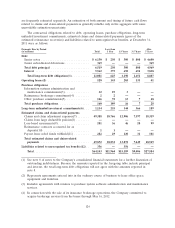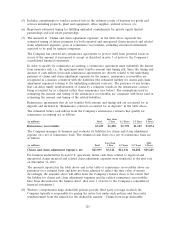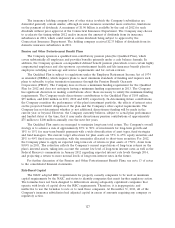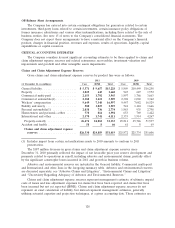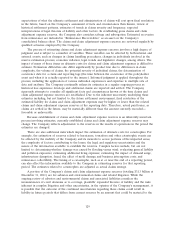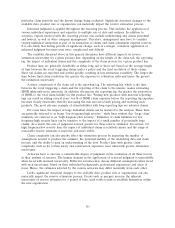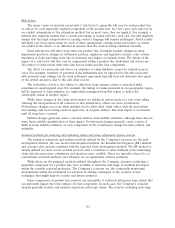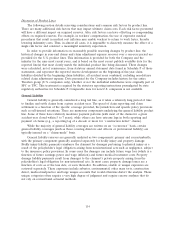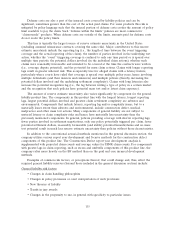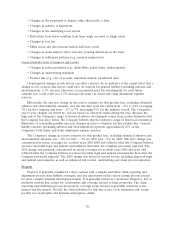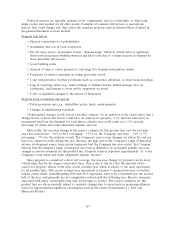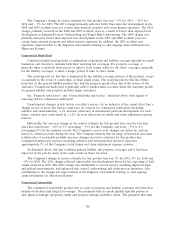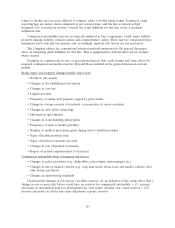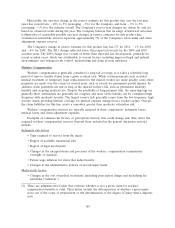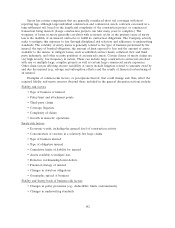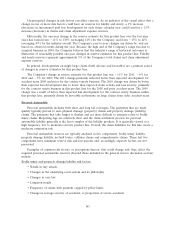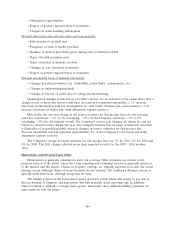Travelers 2011 Annual Report Download - page 146
Download and view the complete annual report
Please find page 146 of the 2011 Travelers annual report below. You can navigate through the pages in the report by either clicking on the pages listed below, or by using the keyword search tool below to find specific information within the annual report.
Discussion of Product Lines
The following section details reserving considerations and common risk factors by product line.
There are many additional risk factors that may impact ultimate claim costs. Each risk factor presented
will have a different impact on required reserves. Also, risk factors can have offsetting or compounding
effects on required reserves. For example, in workers’ compensation, the use of expensive medical
procedures that result in medical cost inflation may enable workers to return to work faster, thereby
lowering indemnity costs. Thus, in almost all cases, it is impossible to discretely measure the effect of a
single risk factor and construct a meaningful sensitivity expectation.
In order to provide information on reasonably possible reserving changes by product line, the
historical changes in year-end claims and claim adjustment expense reserves over a one-year period are
provided for the U.S. product lines. This information is provided for both the Company and the
industry for the nine most recent years, and is based on the most recent publicly available data for the
reported line(s) that most closely match the individual product line being discussed. These changes
were calculated, net of reinsurance, from statutory annual statement data found in Schedule P of those
statements, and represent the reported reserve development on the beginning-of-the-year claim
liabilities divided by the beginning claim liabilities, all accident years combined, excluding non-defense
related claim adjustment expense. Data presented for the Company includes history for the entire
Travelers group (U.S. companies only), whether or not the individual subsidiaries were originally part of
SPC or TPC. This treatment is required by the statutory reporting instructions promulgated by state
regulatory authorities for Schedule P. Comparable data for non-U.S. companies is not available.
General Liability
General liability is generally considered a long tail line, as it takes a relatively long period of time
to finalize and settle claims from a given accident year. The speed of claim reporting and claim
settlement is a function of the specific coverage provided, the jurisdiction and specific policy provisions
such as self-insured retentions. There are numerous components underlying the general liability product
line. Some of these have relatively moderate payment patterns (with most of the claims for a given
accident year closed within 5 to 7 years), while others can have extreme lags in both reporting and
payment of claims (e.g., a reporting lag of a decade or more for ‘‘construction defect’’ claims).
While the majority of general liability coverages are written on an ‘‘occurrence’’ basis, certain
general liability coverages (such as those covering directors and officers or professional liability) are
typically insured on a ‘‘claims-made’’ basis.
General liability reserves are generally analyzed as two components: primary and excess/umbrella,
with the primary component generally analyzed separately for bodily injury and property damage.
Bodily injury liability payments reimburse the claimant for damages pertaining to physical injury as a
result of the policyholder’s legal obligation arising from non-intentional acts such as negligence, subject
to the insurance policy provisions. In some cases the damages can include future wage loss (which is a
function of future earnings power and wage inflation) and future medical treatment costs. Property
damage liability payments result from damages to the claimant’s private property arising from the
policyholder’s legal obligation for non-intentional acts. In most cases, property damage losses are a
function of costs as of the loss date, or soon thereafter. In addition, sizable or unique exposures are
reviewed separately. These exposures include asbestos, environmental, other mass torts, construction
defect, medical malpractice and large unique accounts that would otherwise distort the analysis. These
unique categories often require a very high degree of judgment and require reserve analyses that do
not rely on conventional actuarial methods.
134


